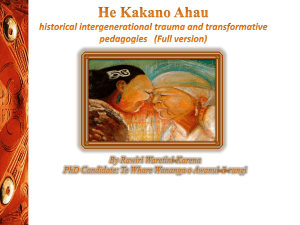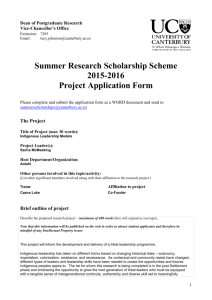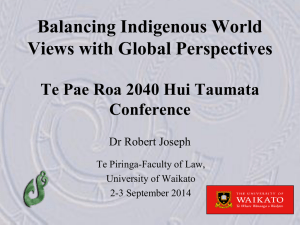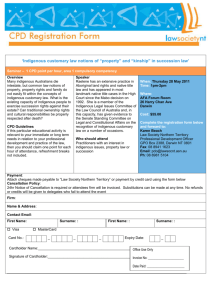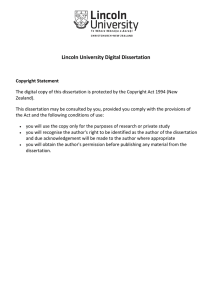The Ethics of Indigeneity - Australasian Association of Bioethics and
advertisement
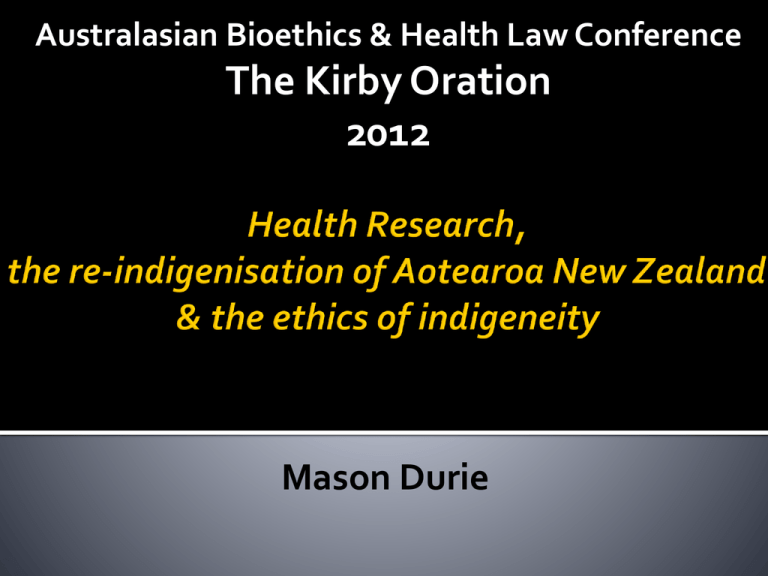
Australasian Bioethics & Health Law Conference The Kirby Oration 2012 Mason Durie Whakarongo, whakarongo, whakarongo mai ra; Whakarongo ki te tangi a te manu nei; Tui, tui, tuituia; Tuia ki runga Tuia ki raro Tuia ki roto, tuia ki waho Tuia ki te here tangata Ki te wheo ao, ki te ao marama. Listen to the call of the Tui bird Calling us all to unite Unite with the skies Unite with the earth Unite people with their ancestral lands Unite individuals with their people In order to live In a world of light He Mihi A word of greeting E nga manuhiri kua tae mai ki Aotearoa, koutou hoki no tenei ao. Tena tatou katoa. Greetings to those of you who are visitors to this country; and also to those who live here. Otira, Ngati Whatua, koutou o te kainga, anei nga mihi whakawhetai ki a koutou i manaakitia mai ki tenei ope e huihui ana ki Tamaki Makaura And special recognition of the local tribe, Ngati Whatua, and to those who have contributed to this conference in Auckland. We have been united by a common quest to discuss the ways in which we can value health and ensure that people can live their lives with dignity and purpose. Stay well Anei tatou i tae mai kia ata tirotiro nga tini take e pa ana ki te hauora tanagta, me nga tumanako mo apopo. Kia ora. Human Rights Human Dignity 5000 indigenous and tribal groups 200 million people 4% of the global population Maori Tribal society (now largely urban) Population 565,000 (15% of total population) Life expectancy 72 years (c.f. NZ 79.9 years) Median age 22.7 years (c.f. NZ 36 years) Over-represented in most categories of illness and injury. Distinctiveness Ecological ties Mana whenua Human encounters Mana tangata Autonomy & self determination Mana whakahaere 3 characteristics The earth mother and the sky father forced apart by their children Separation enabled light and growth • The elements • Forests & birds • The seas, waters, fish • Crops & Ferns • Humankind But connections were retained Spiral Connections between species Outward flow of energy People, land, flora, fauna, water, air, cosmos Relationships and context give rise to knowledge Smaller entities make sense when viewed in relationship to larger entities Centrifugal direction Identity People are part of a wider ecological context Tangata whenua People of the land Turangawaewae A land-based reference point Mauri Relationships between: People and the natural environment Tangible and intangible dimensions Organic and inorganic material Past and future (intergenerational continuity) The microscopic and the macroscopic Tangata whenua (Hosts) and manuhiri (visitors) Marae • Tangata whenua • Social conventions • Whaikorero • Terms of engagement • Tapu • Level of risk • Koha • Reciprocity Autonomy The Treaty of Waitangi 1840 The State Potatau te Wherowhero 1858 The Maori King Tuheitia 2006 Implications Ecological Ties The ethics of eco-connectedness Human Encounters The ethics of engagement Autonomy and self determination The ethics of empowerment Eco-connect Synergies between people and the natural environment Balance between human endeavours and environmental sustainability Longstanding connections between species All environmental forms have a unique ‘mauri’ Balance Human & environmental equilibrium Climate change, carbon emissions Human adaptation to the environment Type II diabetes (living in consumer environments) Species specificity xenotransplantation Species survival Assisted reproductive technologies, organ donations Stem cell research Engagement Relationship building – assessing risk & motive Time Space Agreement on terms Mutual benefits Mutual respect and mutually re-enforcement Implications What is the reason for engagement with Maori ? Is the research seeking a sample of Maori views or a sample of views on Indigeneity ? Who to engage with ? Where should engagement occur ? Long term relationship or ‘one off’ ? Ownership & management of information & data – what arrangements have been negotiated and will they benefit or compromise Maori participants ? Empowerment Informed Consent • Knowledgeable • space to decide • time to reflect Active participation • Involvement in research design Guardianship: • research integrity • Indigenous • advice on environmental research protocol, interests & methods • research data • Researcher as well as ‘subject’ of • dissemination of research results Promoting ethics Shifting researcher attitudes Indigenising ethical standards and protocols Researcher attitudes Ethical compliance Mutual benefits Research method Research impacts Centripetal focus Centrifugal focus Recruitment Active participation Scientific merit Translational gains Consultation Relationship Standards Protocols Declaration on the Rights of Indigenous Peoples (2007) WAI 262 Report of the Waitangi Tribunal (2010) DRIP ‘The Declaration on the Rights of Indigenous Peoples provides a global benchmark for indigenous heritage, justice, and future planning.’ Article 31 Article 31 1. Indigenous peoples have the right to: maintain, control, protect and develop their cultural heritage, traditional knowledge and traditional cultural expressions, as well as the manifestations of their sciences, technologies and cultures, including human and genetic resources, seeds, medicines, knowledge of the properties of fauna and flora, oral traditions, literatures, designs, sports and traditional games and visual and performing arts. They also have the right to maintain, control, protect and develop their intellectual property over such cultural heritage, traditional knowledge, and traditional cultural expressions. Article 32 Article 32 ‘Indigenous peoples have the right to determine and develop priorities and strategies for the development or use of their lands or territories or other resources.’ ‘States shall consult and cooperate in good faith with the indigenous peoples concerned through their own representative institutions in order to obtain their free and informed consent prior to the approval of any project affecting their lands and territories or other resources, particularly in connection with the development, utilisation or exploitation of mineral, water or other resources.’ Wai 262 WAI 262 Matauranga Maori Claim to the Waitangi Tribunal Protection of native flora, fauna, & Maori knowledge Claim 1991 claim (Wai 262) to Waitangi Tribunal Crown’s failure to recognise Māori rights & authority indigenous flora and fauna rights of Iwi in connection with the protection, control, conservation, management, treatment, propagation, sale, dispersal, utilisation and imposition of restrictions. Later expanded to include indigenous knowledge, cultural works such as designs, sacred sites, genetics, indigenous medicinal knowledge, bio-prospecting, commercialisation resulting from Māori knowledge, culture or properties. Report the focus is on the relationship between Māori and the resources concerned. Shared decision-making should be possible without diminishing the significance of tino rangatiratanga (autonomy) The principle of partnership is central to New Zealand’s evolving constitution Partnership should be discussed within a futures framework rather than as a by-product of historic grievance. 262 Summary At the heart of the claim was a concern that the Māori should have full participation in decisions about the natural environment, Maori health and wellbeing, and works arising from Māori cultural knowledge Kirby Justice Michael Kirby An Indigenous Research Ethical Framework Standards & Protocols for Research with Indigenous Peoples The ethics of eco-connectedness Ecological ties The ethics of engagement Human encounters The ethics of empowerment Autonomy & self determination End
